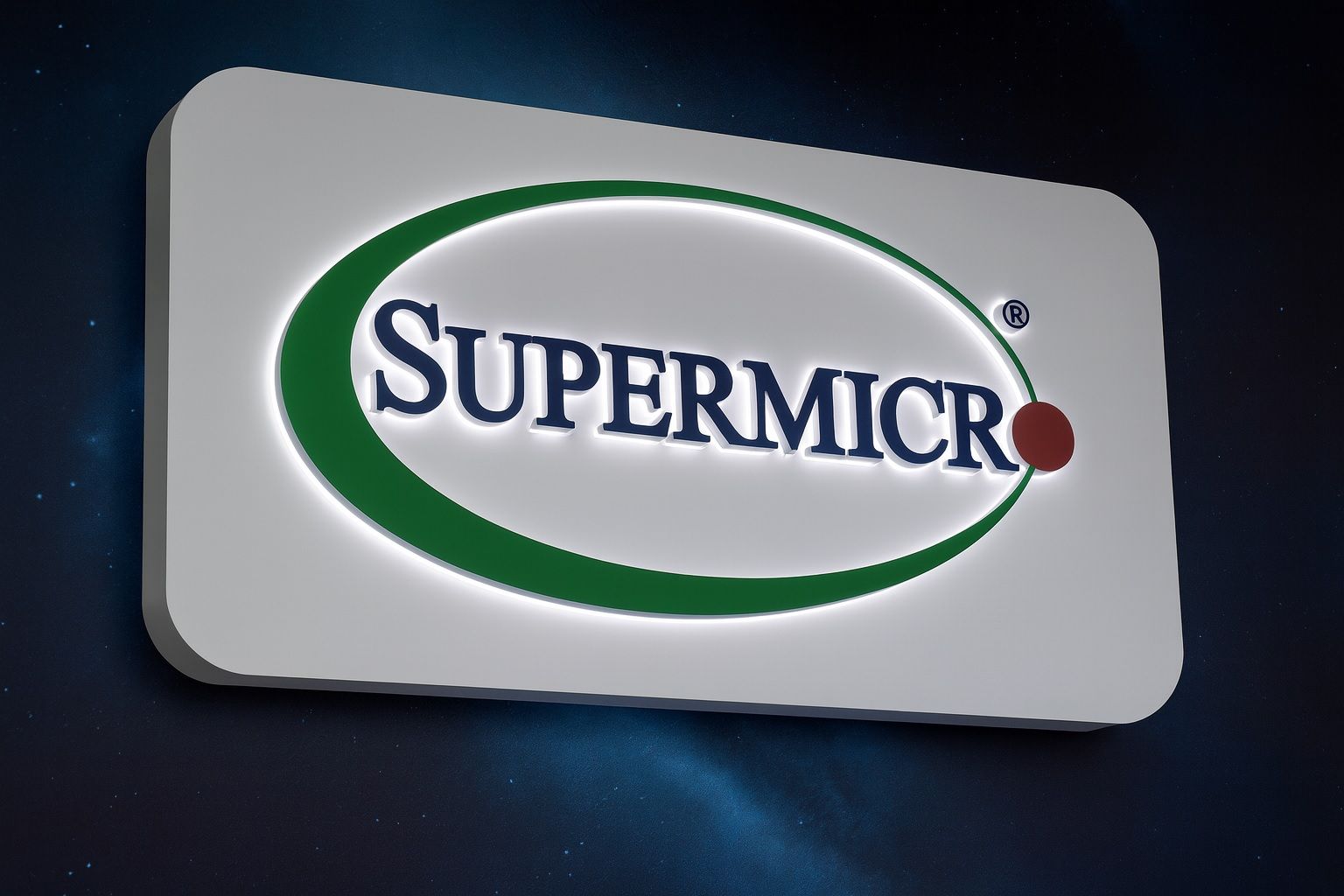- Institutional moves: Major funds are reshuffling SMCI positions. Chevy Chase Trust added ~7,000 shares, raising its stake to 271,104 shares (~$13.3M) [1], and International Assets Investment Management increased its holding 18% to 31,675 shares (~$1.55M) [2]. TD Asset Management, by contrast, trimmed its SMCI position by 3.6% to 238,723 shares (~$11.7M) [3]. (The filings show institutional ownership is about 84% of SMCI’s float [4].)
- Insider selling: Company executives have been offloading stock. CEO Charles Liang sold 200,000 shares (~$12M) in late July [5], while CFO David Weigand and Director Sara Liu sold 25,000 (~$1.13M) and 200,000 (~$12M) shares respectively [6]. In total insiders disposed of roughly 490,000 shares (~$28M) in the past quarter [7].
- Earnings & guidance: SMCI’s latest quarter (Q2 FY2025, ended June ’25) saw EPS $0.41 on $5.76B revenue, missing analysts’ $0.44/$5.88B estimates [8]. Management has guided Q1 FY2026 to ~$6–7B rev and $0.40–$0.52 EPS [9], and trimmed full-year FY2026 sales to “at least” $33B (down from a prior $40B target) [10].
- Stock rally: SMCI shares have skyrocketed in recent weeks. TS2.Tech reports the stock jumped from ~$48 in late Sept to mid-$50s by Oct 6 (about +79% year-to-date) [11]. It opened Oct 20 at $52.18 [12] (Nasdaq data) – far above the late-2024 low – with a 52-week range of $17.25–$66.44 [13].
- Analyst sentiment: Wall Street is broadly cautious. The consensus analyst rating is “Hold,” with average price targets in the mid-$40s [14]. Bulls like Needham point to upside (target ≈$60), but Goldman Sachs recently cut its target to ~$27 amid margin worries [15].
- AI catalysts: Supermicro is riding the AI/data-center wave. On Oct 14 it launched a new “Data Center Building Block Solutions” line – an end-to-end AI infrastructure offering (liquid cooling, pre-validated racks, management software, etc.) [16] [17]. A blockbuster AMD–OpenAI chip deal (Oct 6) gave SMCI a ~6% lift, and CFO Jean Hu said the partnership could drive “billions” in future revenue [18]. The company also rolled out new AI-optimized servers and expanded global manufacturing to meet surging demand for high-density, liquid-cooled data centers.
Institutional Trades and Insider Moves
Recent SEC filings show hedge funds and asset managers are actively buying and selling SMCI stock. For example, Chevy Chase Trust raised its SMCI holding by 2.6% in Q2, acquiring an additional 6,997 shares (now 271,104 shares worth ~$13.3M) [19]. Similarly, International Assets Investment Management boosted its stake 18.3% to 31,675 shares (~$1.55M) [20]. By contrast, TD Asset Management trimmed its position by 3.6%, selling 8,922 shares to hold 238,723 shares (~$11.7M) [21]. (As MarketBeat notes, institutional investors own about 84.06% of SMCI’s stock [22], underscoring the dominance of large holders.)
Meanwhile, insiders have been selling aggressively. SMCI’s CEO Charles Liang sold 200,000 shares on July 28 (~$12M) [23], and Director Sara Liu sold 200,000 shares (also ~$12M) in late July [24]. CFO David Weigand sold 25,000 shares (~$1.13M) on Sept 15 [25]. In total insiders have offloaded nearly 490,000 shares (roughly $28 million) over the last few months [26]. This selling spree – especially by top executives – adds caution even as external investors pile in.
Stock Surge and AI Boom
SMCI has been one of the year’s biggest movers in tech. TS2.Tech highlights that Supermicro shares have jumped dramatically in early October [27]. On Oct 1 the stock closed at $52.39 (up ~10% that day) on record volume [28]. By Oct 6 it was trading around $55, a 15% gain from late September [29]. As of Oct 20 SMCI trades in the low $50s ($52.18 at the open [30]), far above the ~$17 floor reached in early 2024 yet below its post-split high near $66 [31]. Year-to-date the shares are up roughly 79% [32] – well outpacing the Nasdaq-100’s gain.
This rally is widely attributed to the AI/data-center frenzy. Supermicro is a key supplier of high-density, liquid-cooled servers for AI workloads. Market buzz has been fueled by several catalysts: at an Oct 6 event, chipmaker AMD announced an OpenAI partnership (driving AMD +33%) and Supermicro reacted +6%, reflecting its role as an OEM partner [33]. CFO Jean Hu underscored the opportunity, saying the AMD/OpenAI collaboration could yield “billions” in new revenue for Supermicro [34]. Earlier, at an Innovate! conference in late Sept, Supermicro unveiled cutting-edge AI servers with advanced liquid cooling and modular “building block” designs. On Oct 14 the company formally launched its Data Center Building Block Solutions® (DCBBS) – a new business line offering end-to-end AI data-center infrastructure (servers, cooling, power, networking and software) as a single package [35] [36]. These moves aim to make Supermicro a one-stop shop for the booming AI data center buildout.
Earnings Miss and Guidance Cut
Despite the hype, Supermicro’s recent financial results have disappointed. In the June quarter (Q2 FY2025), the company earned $0.41 EPS on $5.76 billion sales, coming in below Wall Street’s $0.44/$5.88B consensus [37]. Net margin was only ~4.8% [38]. Management cited a weaker product mix (more lower-margin hyperscale orders and higher costs) as the culprit. The stock dropped ~15% following those July earnings.
Management has since tempered its outlook. For Q1 FY2026 (quarter ending Sep 2025) Supermicro forecasts about $6–7 billion in revenue and $0.40–$0.52 EPS [39]. Full-year FY2026 revenue guidance was trimmed to at least $33 billion [40], far below the previously hoped ~$40B. (By contrast, Supermicro’s fiscal 2025 revenue reached nearly $22 billion – up from only ~$7B two years earlier [41].) Analysts now expect FY2026 EPS around ~$1.86 [42], down ~37% year-over-year. In sum, the strong top-line growth of the past two years is slowing: marketbeat notes consensus revenues “up only 8.5%” year-over-year in Q2 [43].
Analyst Views & Forecasts
Wall Street is mixed on SMCI. As TS2.Tech reports, the consensus rating is “Hold” [44]. Analysts’ average price targets sit in the high-$40 range – slightly below the current trading level. Some banks remain bullish: Needham (a known SMCI bull) holds an outperform view with targets around $60. Others have turned bearish: Goldman Sachs downgraded SMCI and slashed its target to about $27, citing concerns over weakening margins [45]. Overall, only 1 of 18 analysts rates it a “Strong Buy,” six say “Buy,” but ten say “Hold” and two say “Sell,” per MarketBeat [46].
On fundamentals, analysts do see further growth ahead. Consensus forecasts (pre-earnings miss) envisioned FY2026 revenue of about $32.9B and FY2027 ~$40.9B [47] – roughly double FY2025’s level. EPS is projected to climb to ~$2.62 in 2026 and ~$3.30 in 2027 [48]. (Note: those forecasts largely assume demand stays strong and Supermicro stabilizes its costs.) Fifteen analysts have “Buy” ratings with targets ranging from $34 to $70 [49], reflecting the polarized views. MarketBeat notes the average 12-month target is about $45 (near its long-term average) [50], implying limited upside if guidance is weak.
Notable expert commentary has emphasized the risks. D.A. Davidson’s Gil Luria warns that bigger rivals like Dell and Hewlett Packard could steal deals by bundling full data-center solutions [51]. Susquehanna’s Mehdi Hosseini cautions that “rising competition” and thin AI-server margins may cap Supermicro’s upside [52]. Bokeh Capital strategist Kim Forrest observes that expectations for AI “winners” are so high that even minor hiccups (like this recent earnings miss) can trigger outsized drops in stock price [53]. In other words, the same volatility that drives big gains on the upside can also lead to sharp selloffs if forecasts falter.
Outlook and Forecast
Supermicro’s outlook is thus a mix of high potential and high uncertainty. On the positive side, global AI infrastructure spending is surging (data-center investment may exceed $170B in 2025 [54]), and Supermicro has strategic partnerships with Nvidia, AMD and others to capture this demand. CEO Charles Liang emphasizes the firm’s “best track record” of deploying new NVIDIA-based systems quickly [55]. The new DCBBS product line and recent server launches reinforce Supermicro’s positioning as an AI-focused solutions provider [56] [57].
However, investors should be cautious. The stock is still below its all-time highs despite the recent rally, and the company’s growth is still maturing (after 3 years of triple-digit revenue gains [58], growth will moderate). An unresolved issue in late 2024 – auditor resignations and internal control scrutiny – forced more conservative guidance (citing audit costs as one reason to trim forecasts [59]). On balance, analysts expect SMCI to continue growing strongly, but at a slower pace. As one observer put it, even small stumbles can trigger big moves: “any softness in results triggers large stock declines,” thanks to the already elevated expectations [60].
In sum, Supermicro remains one of the most exciting AI-architecture plays, but it comes with volatility. Investors citing TS2.Tech’s analysis note that current price targets (~mid-$40s) essentially “imply slight downside” from here [61]. If Supermicro can execute its AI data-center strategy (leveraging liquid cooling and turnkey solutions) while managing costs, bulls see the stock heading higher. But if competition and cost headwinds persist, the rally could stall. Given the mixed expert views, SMCI looks set for more wild swings – a classic boom-or-bust momentum story in the AI hardware sector [62].
Sources: MarketBeat filings and analysis [63] [64] [65] [66]; TS2.Tech coverage [67] [68] [69]; Supermicro press releases [70] [71].
References
1. www.marketbeat.com, 2. www.marketbeat.com, 3. www.marketbeat.com, 4. www.marketbeat.com, 5. www.marketbeat.com, 6. www.marketbeat.com, 7. www.marketbeat.com, 8. www.marketbeat.com, 9. www.marketbeat.com, 10. ts2.tech, 11. ts2.tech, 12. www.marketbeat.com, 13. www.marketbeat.com, 14. ts2.tech, 15. ts2.tech, 16. ir.supermicro.com, 17. www.prnewswire.com, 18. ts2.tech, 19. www.marketbeat.com, 20. www.marketbeat.com, 21. www.marketbeat.com, 22. www.marketbeat.com, 23. www.marketbeat.com, 24. www.marketbeat.com, 25. www.marketbeat.com, 26. www.marketbeat.com, 27. ts2.tech, 28. ts2.tech, 29. ts2.tech, 30. www.marketbeat.com, 31. www.marketbeat.com, 32. ts2.tech, 33. ts2.tech, 34. ts2.tech, 35. ir.supermicro.com, 36. www.prnewswire.com, 37. www.marketbeat.com, 38. www.marketbeat.com, 39. www.marketbeat.com, 40. ts2.tech, 41. ts2.tech, 42. ts2.tech, 43. www.marketbeat.com, 44. ts2.tech, 45. ts2.tech, 46. www.marketbeat.com, 47. ts2.tech, 48. ts2.tech, 49. ts2.tech, 50. www.marketbeat.com, 51. ts2.tech, 52. ts2.tech, 53. ts2.tech, 54. ts2.tech, 55. ts2.tech, 56. ir.supermicro.com, 57. ts2.tech, 58. ts2.tech, 59. ts2.tech, 60. ts2.tech, 61. ts2.tech, 62. ts2.tech, 63. www.marketbeat.com, 64. www.marketbeat.com, 65. www.marketbeat.com, 66. www.marketbeat.com, 67. ts2.tech, 68. ts2.tech, 69. ts2.tech, 70. ir.supermicro.com, 71. www.prnewswire.com







